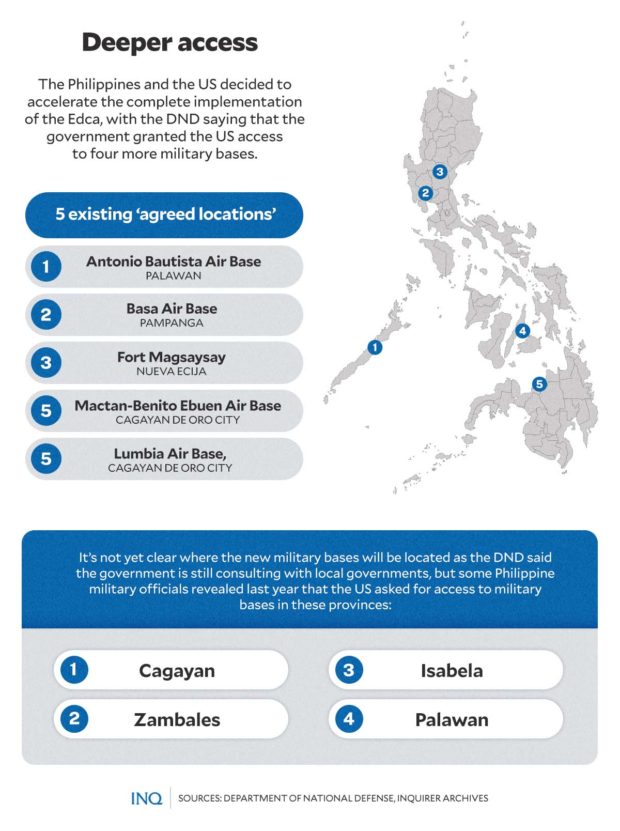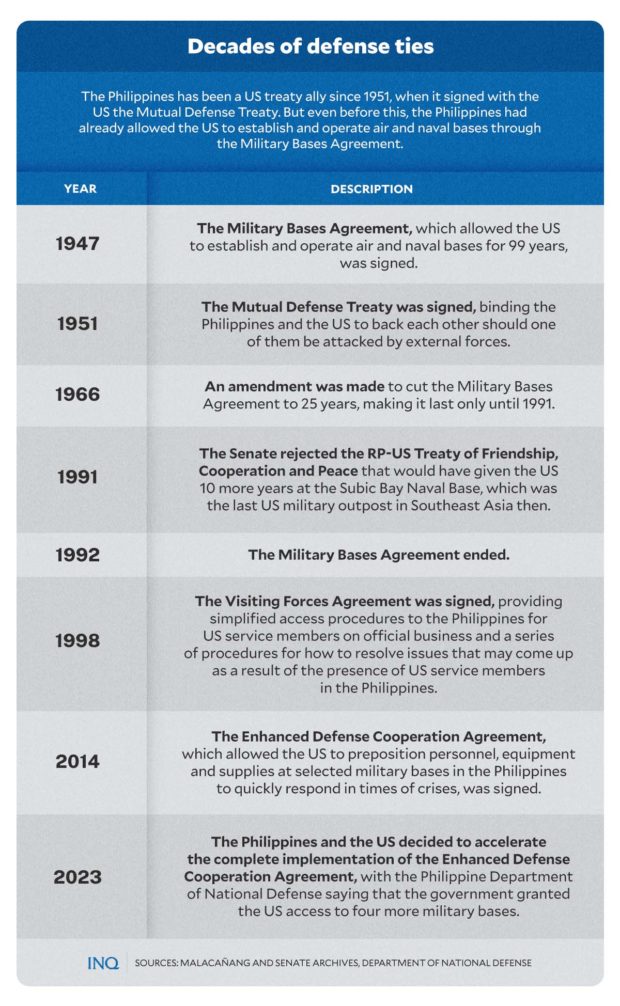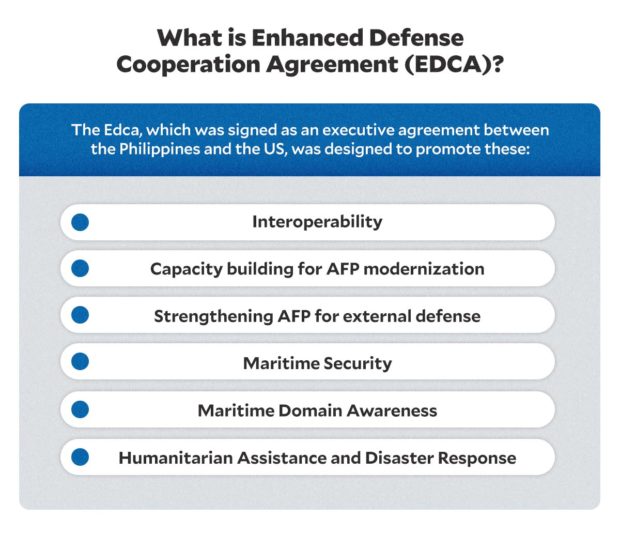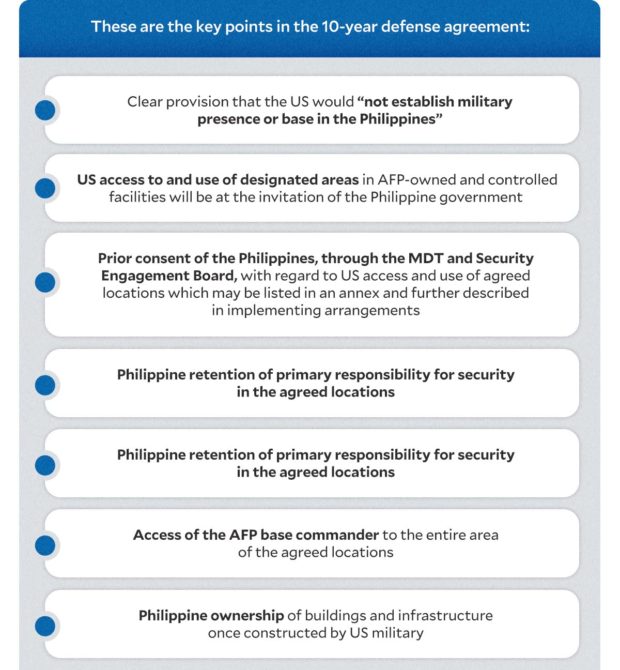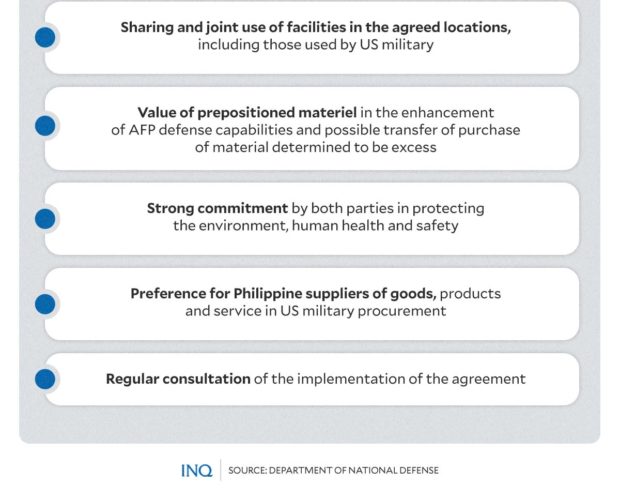Deeper defense ties with US: What it means for PH
MANILA, Philippines—Far from how it was when Rodrigo Duterte was still in Malacañang, ties between the Philippines and the United States (US) are now rekindling, with the two countries accelerating the full implementation of the Enhanced Defense Cooperation Agreement (Edca), which was signed in 2014.
Looking back, Duterte, in 2016, threatened to scrap the 1998 Visiting Forces Agreement (VFA) that provided simplified access procedures to the Philippines for US military men on official business, and a series of procedures for how to resolve issues that may come up as a result of the presence of American soldiers in the Philippines.
But as Ferdinand Marcos Jr. assumed office on June 30, 2022 over a month after winning the presidency with 31,629,783 votes, the Philippines has strengthened its ties with the US, a clear reversal from Duterte’s often-hostile attitude towards the United States, which he once said the Philippines has separated from.
As Marcos said last Feb. 2, “again, I have always said that it seems to me that the future of the Philippines and, for that matter, the Asia-Pacific will always have to involve the US simply because those ties are so strong and so historically embedded in our common psyches that can only be an advantage to both our countries.”
READ: US gets access to more PH bases
This, as the defense secretaries of the Philippines and the US—Carlito Galvez and Lloyd Austin III—announced that the two countries agreed to four more Edca bases.
As Austin said, “from defense perspective, we will continue to work together with our great partners and to build and modernize your capabilities as well as increase our interoperability.”
But what does this mean for the Philippines, which was once home to massive US military presence after World War II?
Expanded Edca
Last Feb. 2, as Austin arrived at the headquarters of the Department of National Defense (DND) in Quezon City on Feb. 2, Galvez said the Philippines granted the US access to four more military bases, amid concerns over China’s continued aggression in the West Philippine Sea and a potential invasion of Taiwan.
The agreement is an expansion of the Edca, which the late President Benigno Aquino III signed with the US in 2014—which the Supreme Court ruled was an executive agreement that was part of the larger agreements VFA and the 1951 Mutual Defense Treaties that needed Philippine Senate nod.
With the expansion, the DND said the Philippines and the US are “proud to announce their plans to accelerate the full implementation of the Edca with the agreement to designate four ‘agreed locations’ in strategic areas of the country and the substantial completion of the projects in the existing five ‘agreed locations’.”
The five existing “agreed locations” are the Antonio Bautista Air Base in Palawan, Basa Air Base in Pampanga, Fort Magsaysay in Nueva Ecija, Mactan-Benito Ebuen Air Base in Cebu and Lumbia Air Base in Cagayan de Oro City. The one in Palawan is the closest to the Kalayaan Island Group, while the one in Nueva Ecija is the country’s largest military camp.
As to where the new Edca bases will be located is not yet certain, with Galvez saying that the government is still consulting with the local governments concerned.
READ: US, PH agree to four new Edca sites
“We withhold the announcement of the Edca sites because our protocols and also our diplomatic notes have not been completed.”
“We need to complete all the staff work, including our consultations with the local government units,” Galvez said.
But looking back, some military officials revealed last year that the US asked for access to military bases in Cagayan, Zambales, Isabela and Palawan, provinces that face either the West Philippine Sea or Taiwan.
PH-US relations
The Philippines has been a treaty ally of the US since 1951, when it signed with the MDT that bound the two countries to support each other should one of them be attacked by external forces—an agreement which the US said is a foundation for close security cooperation between the two countries.
But even before the MDT was signed, the Philippines had allowed the US to establish and operate air and naval bases for 99 years in 1947 through the Military Bases Agreement (MBA), which was later amended to reduce the tenure to only 25 years. As a result, the agreement was expected to end in 1991.
The US had the chance to extend its tenure, but the Philippine Senate rejected in 1991 the RP-US Treaty of Friendship, Cooperation and Peace that would have given the US 10 more years at the Subic Bay Naval Base, which was the United States’ last military outpost in Southeast Asia then. The MBA ended in 1992.
However, in 1998 and 1999, the VFA was signed and ratified, providing simplified access procedures to the Philippines for US service members on official business and a series of procedures for how to resolve issues that may come up as a result of US service members being present in the Philippines.
As the Center for Strategic and International Studies (CSIS) said, the VFA “provides clear procedures and processes for how to handle issues that arise as a result of the presence of US service members in the Philippines,” like what happened in 2015, when “a US Marine was tried and convicted of killing a Filipina.”
It was referring to the case of American soldier Joseph Scott Pemberton, who was sentenced to 12 years imprisonment. But because of the VFA, he served his sentence in a facility established by the Philippines and the US rather than the New Bilibid Prison.
He was released in 2020 through absolute pardon granted by Duterte, a move condemned by progressive groups.
The CSIS also said the VFA is a “political signal of the closeness” of the alliance between the Philippines and the US, with “analysts and former officials believing that signaling close ties between the US and the Philippines supports efforts to deter China from further encroaching on Philippines’ sovereignty.”
Over 15 years later, the Edca was signed, allowing the US to preposition personnel, equipment and supplies at selected military bases in the Philippines to quickly respond in times of natural disasters and other crises. This, however, was criticized as a violation of the Constitution.
As explained by international studies professor Renato de Castro, the agreement allows US service members to use facilities owned and controlled by the Armed Forces of the Philippines (AFP), but ensures that the base commander of the Philippines retains free access to those locations.
“Likewise, the US military will be able to build or improve the infrastructure inside these installations, but Philippine forces will be able to jointly use them. Any construction and other activities within Philippine bases requires the consent of the Philippine-US Mutual Defense Board and Security Engagement Board,” he said.
Stronger defense?
The DND said Edca is designed to promote between the Philippines and the US interoperability, capacity building toward AFP modernization, strengthening AFP for external defense, maritime security, maritime domain awareness, and humanitarian assistance and disaster response.
De Castro explained in 2016 that once the Edca is implemented, a contingent of US service members will be deployed to the Philippines on a short-term and rotational basis: “This will probably include the stationing of a squadron of US Marine fighter planes in a Philippine Air Force base for six months,” he said.
He said US service members will be stationed in the country through these access arrangements—the forward operating sites, which are expandable and partially equipped facilities with limited US military support presence, and cooperative security locations, which are facilities maintained by the Philippines with little or no constant US presence.
RELATED STORY: What is the Enhanced Defense Cooperation Agreement and what does it mean for PH?
The presence of the US military will strengthen the Philippines’ resolve to uphold its territorial and maritime claims in the West Philippine Sea, De Castro, who is also a member of the Board of Trustees of the Albert Del Rosario Institute of Strategic and International Studies, said in a CSIS column.
“By increasing the US’ ability to respond to crises in the South China Sea (West Philippine Sea), the Edca could also test American credibility regarding its defense commitment to the Philippines,” he said.
“Though the maritime row in the South China Sea will be a long-term security challenge and will never be solved solely through force, the potential for an armed conflict requires the presence of an effective US deterrent force in the region. The Edca is aimed at producing such a deterrence posture,” he added.
Take as an example what former SC Senior Associate Justice Antonio Carpio said after a China Coast Guard ship struck a patrol vessel of the Philippines with military-grade laser that harmed some of its crew, an action which he said constitutes an armed attack: “The Philippines can thus invoke the MDT.”
READ: Carpio: PH can invoke MDT on Chinese laser ‘attack’
With China’s aggression, Carpio told ANC on Wednesday (Feb. 15) that the Philippines really has to think of strengthening its alliances, stressing that “you have to look at the history of the South China Sea”—1995, the Mischief Reef was seized; 2012, the Scarborough Shoal was seized; 2017, Sandy Cay was seized.
He said China’s actions are not a reaction to the recent visits of Austin and even US Vice President Kamala Harris to the Philippines, saying that China has long planned this. With this, he said setting aside the Permanent Court of Arbitration’s 2016 decision and setting aside relations with treaty allies will not stop China.
“We have to use allies,” he said, taking as an example countries that want the US to stay as an assurance that they will not be left behind.
“Us, what is our assurance? Our assurance is Edca,” he said, explaining that while the Philippines does not want to station US service members, equipment should be kept in bases so that the military can use it when there is a crisis.
Fast response, economic gains
Back in 2014, the DND released some of the key aspects of the Edca, including its purpose and how to attain its objectives. As it said then, “we are currently holding joint training exercises such as Balikatan and undertaking humanitarian assistance and disaster relief cooperation such as in the aftermath of Typhoon Yolanda (Haiyan, the strongest typhoon to hit land).”
It explained then that “to improve on the above, we intend to undertake additional cooperation by way of construction of facilities and infrastructure upgrades, and storage and prepositioning of defense and humanitarian assistance and disaster response equipment, supplies and material.”
Looking back, when Yolanda, which was considered the strongest to ever hit land, struck the Visayas in 2013, the VFA allowed for some 13,000 military men, 66 aircraft, and 12 naval vessels to deliver more than 2,500 tons of relief goods and evacuate over 21,000 people.
Likewise, Galvez said the Edca expansion is not only about security and defense but also economic gains, especially for the communities and local government units (LGUs) that will host the military bases, aside from strengthening their protection from the effects of climate change through intensified mitigation efforts and more immediate disaster response.
“It is our fervent hope that our LGUs will also realize that the Edca is not just about security. We enjoin them to look into potential foreign investments and economic development that Edca sites will bring to their communities, as well as the enhancement of the protection of our areas that are vulnerable to the effects of climate change and the quicker response and mitigation if our front liners are called to action,” he said.
To date, the US has allocated over $82 million in infrastructure investments in the existing five sites.
As written by William Berry Jr., “most Filipino opponents and proponents of the bases agree that the bases do contribute to the economy,” however, “they tend to disagree as to whether the Philippines could make the necessary adjustments to absorb the economic dislocations if the bases close.”
He stated that the Philippines has received $481 million in US compensation yearly as a result of the MBA, but “compensation in the form of economic and military assistance programs is only part of the economic equation.”
“Employment opportunities, local contracting, American support for international loans to the Philippines, and the possible attraction of foreign investment are also some of the economic effects involved directly or indirectly with the presence of the bases,” Berry said in his article “The Effects of the US Military Bases on the Philippine Economy.”
He said employment was a big problem for the Corazon Aquino administration then, not only because of the economic decline which took place in the last years of Ferdinand Marcos Sr.’s regime, but also because of the expanding population that placed a strong demand for the government to create new jobs.
Back then, the US military bases was the second largest single employer in the Philippines after the government itself. Berry said at the conclusion of the fiscal year ending in September 1987 that the bases employed 68, 514 Filipinos—23,168 full-time employees, 22,834 contract employees, 22,068 domestics and private hires, and 444 concessionaires.
“Wages paid to base employees in 1987 totaled more than $96 million,” he said. Likewise, the MBA amendments included provisions encouraging the US to increase local procurement of products required by the bases, and the US has attempted to comply with these obligations, Berry said.
Clark Air Base, for the fiscal year ending in September 1987, purchased more than $53 million worth of goods and services from Filipino contractors, ranging from cement for aircraft runways to food, like vegetables, sold in the commissary. Then at the Subic Naval Base, the US spent more than $150 million.
Concerns still persist
But of course, this is just one side of the picture as concerns as to whether the presence of US military in the Philippines would bring good or not still persist, like ACT Teachers Rep. France Castro, who stressed on Feb. 4 that “as Filipinos, we have a responsibility to uphold the Constitution and never give up the sovereignty of the Philippines.”
“Let us not sacrifice our sovereignty on the promise that they are here for ‘mutual defense’ and supposed visit, because the damage and disadvantage to our people are greater than the gains. Let us end their excursion into our country and let us not allow ourselves to be used as pawns of their war,” she said.
Castro also warned of the possibility of the Philippines being used as a testing ground for US nuclear weapons based on the 123 agreements brandished by Harris on what she called “civil” nuclear cooperation.
The Edca expansion also prompted the Bagong Alyansang Makabayan to stress that the Philippines should not be allowed to be used as a “staging ground” for what it called US military intervention in the region.
Even House Deputy Speaker Ralph Recto raised concerns on the expansion: “In principle, this is an administration prerogative I support. But I ask that whatever agreements be made public and the pros and cons be told.”
“National security is not harmed by that candor. But any secrecy will deal with transparency, an avowed hallmark of this administration, a serious blow,” he said.
READ: Recto to Marcos: Disclose location of new Edca sites, reason for expansion
Recto then asked how the Philippines will benefit from expanding Edca sites in the country.
“Will the nation win with that move? And what are the possible nuisances that it may cause, if any?”
“How many more military bases will they have access to as time passes? Are we being built up as their armed garrison in the Pacific as a tripwire to Chinese expansionism?” he said while asking defense officials to thoroughly review the agreement’s “ramifications, specifically the potential reaction from other states and our planned responses,” Recto said.
RELATED STORY: PH should get fair share in 1951 Mutual Defense Treaty, says JV Ejercito
TSB

